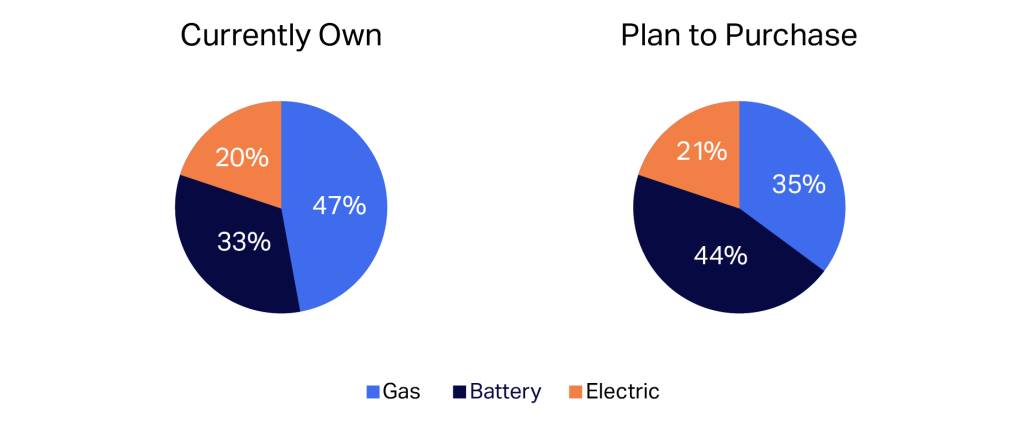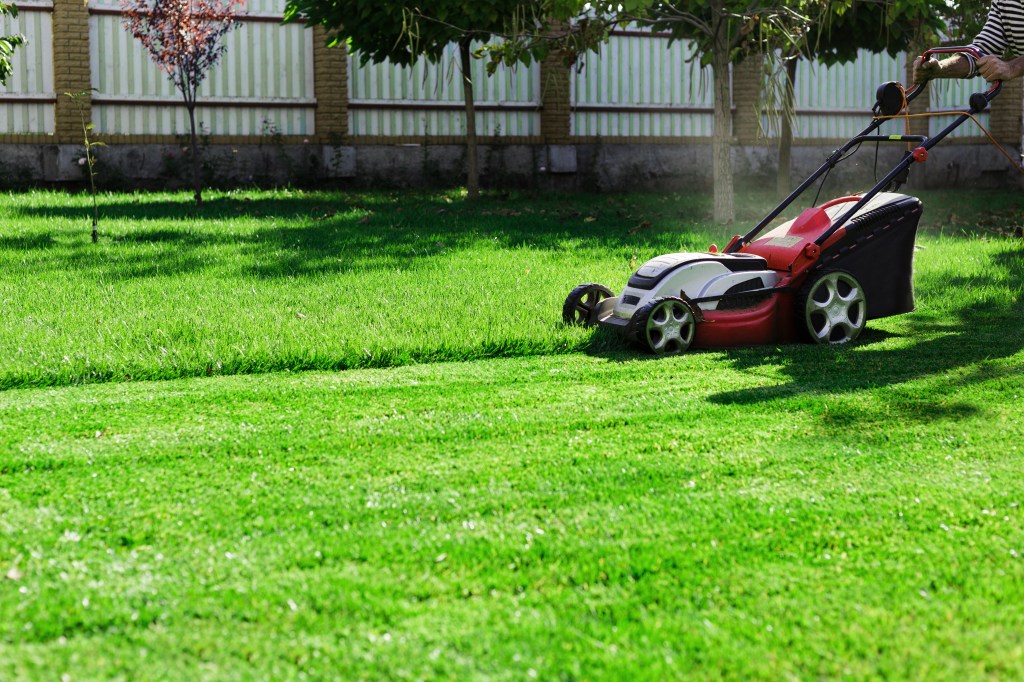Changing dynamics in LawnTech
Changing technology dynamics and market opportunities are roiling many traditionally staid durable categories as consumers perception of their value changes and technological advancements restructure how the consumer sees the category. Lawn equipment is probably the most advanced in navigating this change, and in fact is in some ways on its second act with regards to the embracing of new technology.
For many years, electric-powered equipment—mowers trimmers, etc. was expected to challenge the gas model for dominance. But over the past few years, battery technologies have made rapid advances and significant inroads in both market share and in mind share.
Traditional gas vs. battery/electric trends
While gas remains the dominant technology, powering almost half (47%) of all outdoor power equipment used by consumers, battery-powered equipment now represents 1/3 of the installed base, uncovered by NIQ’s Lawn and Garden Consumer Study. More telling is that in the future, 44% of consumers expect to purchase battery-powered outdoor equipment, while gas equipment is only favored by 35%. If this trend plays out, it is likely that battery-powered equipment will take center stage in the category.
Today’s Lawn Equipment:
Owners vs. Future Owners

Battery and electric powered models dominate the blower and trimmer market with 70% ownership share. Additionally, 60% of those blowers and trimmers are battery-powered, making battery power the largest power source in this segment.
The push mower market has a different vibe based on its very different usage patterns. Nearly 65% of the push mower market remains gas-powered, with battery mowers representing more than double the installed base volume of electric power.
What do consumers value?
Different value expectations for electric and battery mowers create this wide gulf in current ownership rates. Push gas mower buyers were 2.5 times more likely to cite price as the most important purchase factor vs power source. Less than 15% of gas mower owners cited any usage or value-based attribute (yard size, sustainability, terrain etc) as being an important factor in their purchase—focusing instead on price, brand, and power.

For both electric and battery owners the value proposition is much more nuanced. These consumers viewed power source for their mower as nearly equal or above price in value. In fact, electric buyers were more likely to see power source as more important than price. Over 20% of electric buyers and more than 25% of battery buyers felt those usage attributes were the most important factor to their purchase.

Electric mowers lose ground to battery
Within the alternative segments, electric mowers continue to lose ground to battery powered devices as the usability factors offset the value of electric vs battery once the consumer has chosen to use an alternative power source. Yard size is an important proxy for range anxiety in battery purchases (and for cord length fears for electric mowers as well) and the importance of yard size (and duration of use) for battery owners far outpaces the concern for sustainability in key purchase motivators.
Battery power still has an uphill battle to make the sustainability metrics important enough to offset usability, with yard size 4 times more important to current purchasers than sustainability. For electric buyers, this story is much more obvious as sustainability is just as important as yard size in making their product choice.
The future of LawnTech belongs to…
Battery-powered is gaining traction among consumers vs gas mowers, and this is growing popularity is why consumers are expecting that their future mower choice is likely to be battery powered. Future buyers are much less concerned about yard size for battery-operated mowers than the current owners are, and they remained concerned about sustainability. Electric buyers mostly remain equally concerned about those two key purchase factors.
For future gas buyers the story is still largely the same with most intentions focused on brand, price, and power, so as attitudes and buyer values shift, demand for gas is likely to decline. The improvement in battery technology will give OPE owners more comfort about battery-operated mowers (as they are about trimmers and blowers) and validates the shift to batteries the market is seeing is likely to be sustainable.
What’s driving the push mower market?

The demographics support the changes expected in the category over the next few years. Affluent families and evolving adults far over index in non-gas mowers while rural and downscale owners are more inclined to own gas mowers.*
In addition, we see that the favorability of electric and its consistent demand is also likely in part to some level of self- selection of its demographics. Electric buyers, while not growing, have already bought electric as likely owners of compact yards where the challenges of cord length and access to electricity are much less prevalent. This is apparent as nearly 30% of electric owners live in the Northeast where the population lives in higher density with smaller lot sizes.
The verdict? Battery mowers are likely to steal share from gas going forward.
Implications for lawn care marketers
The long-term growth of the battery outdoor power equipment market (and the stability) of the electric market seems inevitable as consumers adjust expectations. The categories focus more intently on what is important, and the innovation of the segments continues to grow.
Consider these factors for both retailers and manufacturers:
- Focus on product capabilities such as better battery technology and more robust battery capacity
- Innovate against those hard attributes in outdoor power equipment
- Sustainability will still remain an important marketing tool
Given the nature of the future users and the demand from buyers for better sustainable alternatives (at the same capability of traditional gas products) the expectation should be for a continued pivot from the brands and retailers towards those features and attributes. This has been the playbook for blowers and trimmers and the consumer has responded. Addressing the need for these tools to be able to do the job at hand, without limitations, will be the best focus for manufacturers going forward.
As one consumer put it:
“The eco-friendliness of the electric/battery is appealing; however, the ease and familiarity of the gas seems to be the easier choice. I would hate to mow over an extension cord with an electric mower and I would hate for my battery to run out midway through the job”

What’s powering the future of lawncare equipment?
Download the Changing dynamics in LawnTech infographic to get a deeper understanding of what’s powering the future of lawn care equipment.
Interested in learning more about Nielsen IQ’s Lawn & Garden study?
Source
NIQ’s Lawn and Garden Consumer Study
*Spectra BehaviorScape: Penetration/Spectra 2024
Jun/MRI-Simmons Adult Usage




